Last time I said I’d keep going to my sit spot at night. Um, it’s less than 60°F at night now, so that’s out of the window. I left my room at 4:00pm to head over to my sit spot. To get t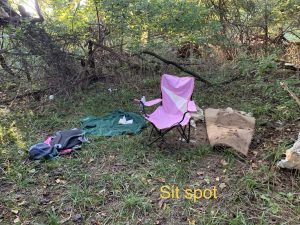 here, I leave from Tinker and walk through the specialty housing “neighborhood” (Eastwards), until I reach 2 parking lots. From there, I walk through the parking lots, until I see a fenced area in the grass lot past the parking lots. I walk towards the trees to the right of the fenced area until I see an opening. A few (5-15) steps into that, there’s a clearing to the left. That’s my sit spot! Don’t visit – that’s my mask-off area.
here, I leave from Tinker and walk through the specialty housing “neighborhood” (Eastwards), until I reach 2 parking lots. From there, I walk through the parking lots, until I see a fenced area in the grass lot past the parking lots. I walk towards the trees to the right of the fenced area until I see an opening. A few (5-15) steps into that, there’s a clearing to the left. That’s my sit spot! Don’t visit – that’s my mask-off area.
This time, I think because I went before sunset, I was able to hear many more animal emitted noises. The sight was the same as before, dead leaves all around, tree branches surrounding me and curved toward me. Relatively clear, light blue sky. The only noticeable difference is that now it was obviously brighter, sunnier, clearer. The weather was pleasantly cool, but I eventually had to wrap a blanket around myself because the temperature suddenly started to drop, and this small breeze made an enormous difference.
There were two sounds I distinctly recognized: cicadas and grasshoppers. The cicadas in my area were, for some reason, quieter than the cicadas I’ve heard on Front Quad. I’m not sure why – I would’ve expected cicadas to be louder in wilder, more natural areas. Maybe it’s because I went close to sunset, so some were asleep? The grasshoppers’ sound didn’t have anything special or significant about it beyond the chirps we’ve all heard before. I also heard two birds. One had a loud, short caw with no echo. Because it cawed, I’m assuming it’s a larger, possibly predatory bird. The other bird I heard had a loud, high-pitched whistle – although I expected to hear at least one other bird call ba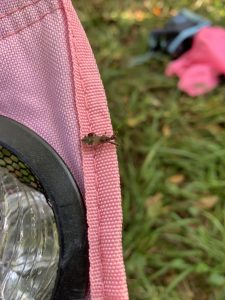 ck to it, its call was followed by near-silence. I also heard another bird that had a distinctly different sound from the others – this one’s sound was closer to a song. It would sing for about 1-3 seconds, stop, then repeat the same pattern (IMG_3393).
ck to it, its call was followed by near-silence. I also heard another bird that had a distinctly different sound from the others – this one’s sound was closer to a song. It would sing for about 1-3 seconds, stop, then repeat the same pattern (IMG_3393).
Toward the end, on my chair, I noticed an insect that I couldn’t identify. It had a thin body under a wide set of what looks like wings. It didn’t fly, though, so I don’t think they’re actually wings. It seemed to crawl toward me, so I freaked out and flicked it off the chair. Don’t worry – it grabbed onto a leaf very quickly and went about its day.
The 3 things I decided to follow were a groundcover plant, an old rug, and a plant with some tiny yellow flower bunches.
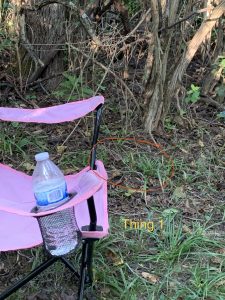 I was curious about bites on the groundcover plant’s leaves, and why some leaves didn’t have any bites. However, when I went back to look, the whole plant wasn’t even there anymore. It’s gone, with no trace. I’m assuming it all got eaten, which means that insects probably just hadn’t gotten to the healthy leaves from last time just yet. Although it’s possible, I don’t think it just died, because I didn’t see any dead leaves that matched the leaves I saw on it before at that location. As for the rug, I was wondering if any insects
I was curious about bites on the groundcover plant’s leaves, and why some leaves didn’t have any bites. However, when I went back to look, the whole plant wasn’t even there anymore. It’s gone, with no trace. I’m assuming it all got eaten, which means that insects probably just hadn’t gotten to the healthy leaves from last time just yet. Although it’s possible, I don’t think it just died, because I didn’t see any dead leaves that matched the leaves I saw on it before at that location. As for the rug, I was wondering if any insects

would decide to use it as shelter. Expectedly, once I opened the rug, I did find several insects, some of which were very upset about losing their privacy. The first one I noticed was a long, moderately-sized insect. I didn’t get to observe it any further as it ran off as soon as it was exposed. I also saw several earthworms, some fatter than others, and a tiny, brown grasshopper. The grasshopper also left the scene very quickly. I then began to observe the yellow flowers. Previously, I was curious about whether they were dying because their season is ending, or growing because their season is starting. However, it turns out they’re very likely dying; this time, the plant’s leaves were browned and a bit wilted. The flowers looked a lot more fragile than last time, and many had lost their petals. I think next time they’ll likely be completely dead.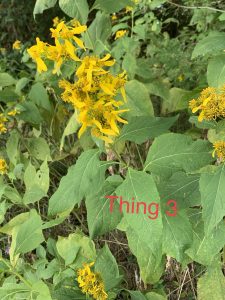

I wanted to walk around my site, as I did last time, because sitting in one specific spot feels like more of a relaxation experience than anything that has to do with curiosity or observation. Walking around got me more interested in my surroundings and let me get more out of my experience. While doing so, I noticed some woody vines to my right (NE) covering a leafless tree. At first glance, I didn’t even notice they were vines; they didn’t really look like anything to me. However, during my observation, I noticed that they were probably parasitic vines that took all the nutrition away from the tree, and that’s why it’s completely leafless. Looking around further, I saw a plant that had some browning, dry leaves. When taking a closer look, I noticed that most of the leaves on a plant were brown or white, and, I’m assuming, very close to death. However, only parts of the leaves were discolored, while other parts on the same leaves seemed healthy. Because the plant right next to it also seems to be doing fine, I think the plant I observed may have some fungal infection that’s causing this discoloration.
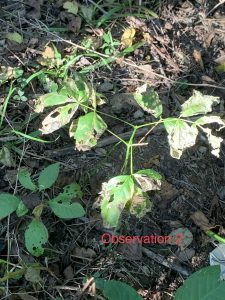

By the time I decided to look for plant adaptations, I wasn’t sure what to look for. The first thing I thought of was to look for plants with hair or spines; I couldn’t find any. Next, I thought of root lengths. I had no idea how to tell the relative length of a plant’s roots without pulling the whole thing out of the ground, and I obviously didn’t do that. Next I thought of leaf size, and I found a plant that had large leaves. I think it probably has that size of leaf to adapt to the low-sunlight conditions in this area, especially considering it’s relatively close to the ground.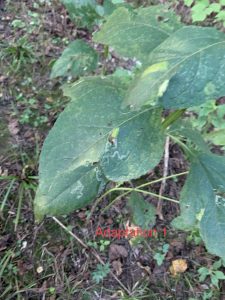 I didn’t know where to go next from there, so I asked a more outdoorsy friend for help. I found out that the vines I observed earlier probably adapted to steal nutrition from trees because they weren’t capable of getting enough nutrition on their own. My friend also knew the relative sizes of some roots, so she helped me find a plant that probably adapted to low-rainfall conditions.
I didn’t know where to go next from there, so I asked a more outdoorsy friend for help. I found out that the vines I observed earlier probably adapted to steal nutrition from trees because they weren’t capable of getting enough nutrition on their own. My friend also knew the relative sizes of some roots, so she helped me find a plant that probably adapted to low-rainfall conditions. 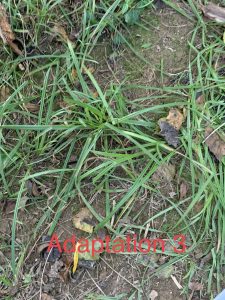 This plant apparently has short roots, but it also has long, thin leaves. I’m assuming that the thin leaves were enough to adapt to the low-rainfall conditions, so its roots remained short. Also, I think that by having longer leaves, the plant also gets better access to sunlight.
This plant apparently has short roots, but it also has long, thin leaves. I’m assuming that the thin leaves were enough to adapt to the low-rainfall conditions, so its roots remained short. Also, I think that by having longer leaves, the plant also gets better access to sunlight.

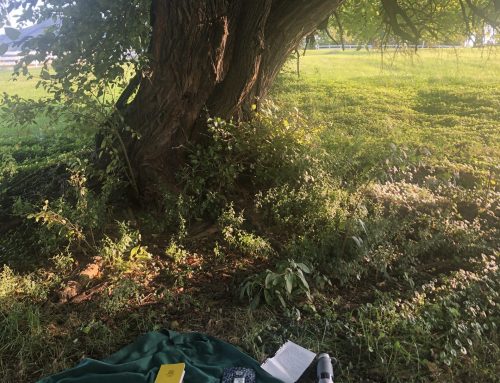
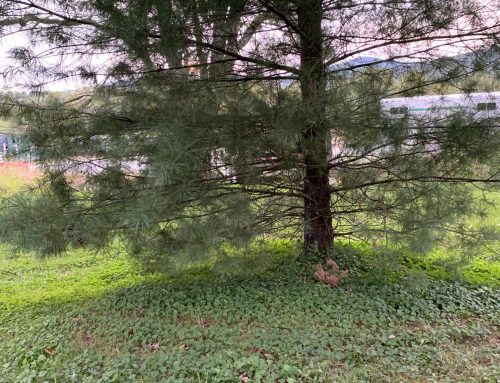
I think you did a really great job keeping your blog interesting and keeping it consistent with your own thoughts and experiences. Once again, I felt like I knew exactly what you were thinking and feeling when I was reading your sit spot. I would like to say that I really enjoy your writing style because it is very casual and humorous; it allows the reader to enjoy themselves while reading your piece. I did want to say that I had somewhat of a similar experience when I went to my sit spot; I was also observing some flowers and they had also begun to die because of the dropping temperatures. I think that it’s also really interesting that you got to observe a potential fungal infection in one of the plants you observed; however, I wonder if you would potentially be able to identify this fungus in the future.
Isn’t it interesting how the volume of the cicadas can be much quieter than expected? I’m constantly amused by their quietness in places I’d expect them to be deafening. I wonder if this is because they don’t have to compete against the volume of other noises?